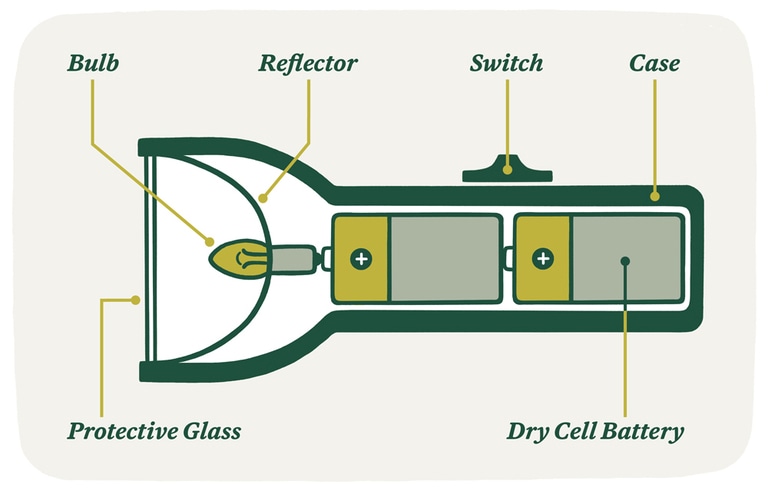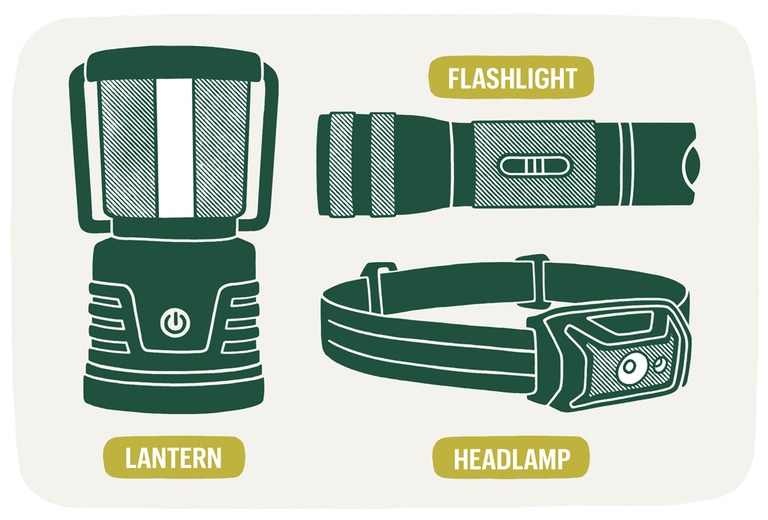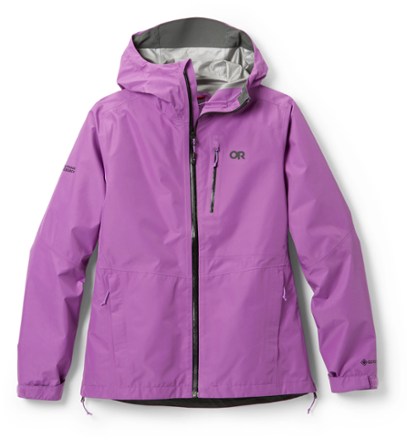Although headlamps have surged in popularity, flashlights remain a good choice whenever a handheld light is preferred, such as:
- any time you want the strongest portable beam available.
- when dexterity and precision in controlling the light is important.
- being able to set down a light to work on a task.
- signaling.
Advances in LED (light-emitting diode) technology and battery efficiency have resulted in flashlights that are smaller, lighter and brighter than they were just a few years ago.
While there’s no one-size-fits-all solution, here’s our best advice to help you choose the best flashlight for your next adventure.

Understanding Your Flashlight Choices
Flashlights range from under $20 to over $200, yet they may be the same size. What are the differences? Brightness is the biggest one. A pricier light is more powerful due to advanced bulb, battery and circuitry technology. A rechargeable battery can add to the cost, as can features such as strong impact- and water-resistance, effective heat dissipation and multiple lighting modes.
Introduced in 2009, ANSI/NEMA FL1 flashlight standards ensure that models are tested and rated similarly. Compliance with these standards is voluntary, and the manufacturers do their own testing, but most major reputable brands now include performance data on their packaging.
Some key factors to compare when selecting a flashlight are:
- Beam distance
- Impact-reistance
- Water-resistance
- Modes
- Controls
- Materials and shape
- Size and weight
- Accessories
Shopping in person? Check out the following:
-
How does the light switch on and off? Could it be inadvertently switched on inside your pack? Or, if you plan to use it in cold conditions, how easily could you switch it on or off wearing gloves or mittens?
-
Does it appear rugged enough (or, conversely, light enough) for your needs?
-
How does it feel in your hand?
-
Is a tool required to change batteries?
Light Output
Measured in lumens . This is a measure of the intensity of the light coming out of the flashlight on the highest brightness setting powered by new batteries. It may also be shown for multiple light settings. This is a great comparison tool, but does not tell the whole story about brightness. Beam intensity, distance and type all influence the effectiveness of a light in different applications. Light output can range from a modest 20 lumens (great for reading a book) to a terrain-scorching 3500 lumens.
Beam Distance
Measured in
meters
. This is how far the light will shine before the brightness diminishes to the equivalent of the light from a full moon. Full moon illumination is considered adequate for safe and careful travel outdoors. This distance will vary with the brightness setting selected. If you prefer your measurements in feet, the calculation is fairly simple. 1 meter = 3.2808 feet, so if your flashlight’s beam distance is 10 meters, that’s 32.084 feet.
Here’s how lumens and beam distance can work together in your flashlight and brighten your outdoor activities.
|
Lumens |
Distance |
Best For |
|
1–250 |
Up to 80 meters |
Everyday and leisure activities in dim conditions |
|
160–400 |
Up to 100 meters |
Camping, hiking, backpacking |
|
400–1000 |
Up to 200 meters |
Hiking, backpacking, caving, campervan engine repair |
|
1000–30000 |
Up to 350 meters |
Fishing, hunting, rock climbing |
|
3000–70000 |
Up to 500 meters |
Extreme weather conditions, mountaineering, emergency rescue |
|
7000–15000 |
Up to 700 meters |
Extreme weather conditions, emergency rescue, mountaineering, activities that require lighting a large area |
Running your flashlight on high output gives the brightest shine, but also quickly drains your battery. Running it on a lower setting gives you less brightness, but more beam distance.
Run Time
Measured in hours . How long does the light output take to drop to 10% of the rated output on new batteries, rounded to the nearest quarter hour? Light output may gradually decrease over time, or remain largely constant and then suddenly decrease. Run time is commonly given for each light setting. A Runtime graph, if available, provides the best illustration of the performance of a light over time.
Impact Resistance
Measured in meters . Lights are tested by dropping them six times onto concrete at the rated distance. This test is primarily to ensure the light remains functional after occasional accidental drops. It is not a test of resistance for a light being run over, being struck with a heavy object or being used to strike other objects.
Water Resistance
Rated using the IPX system (Ingress Protection Standards). Water resistance is important if using your light in the rain or around bodies of water. These ratings are used:
|
Rating |
Protected From |
Best Uses |
|
IPX1 |
Dripping water |
Activities in dry conditions |
|
IPX2 |
Dripping water tilted at 15 degrees |
Activities in dry conditions |
|
IPX3 |
Spraying water |
Activities in dry conditions |
|
IPX4 |
Splashes |
Activities in dry conditions or light rain |
|
IPX5 |
Splashes, water jets |
Activities in dry conditions or light or moderate rain |
|
IPX6 |
Splashes, powerful water jets |
Outdoor activities with a slight risk of water damage |
|
IPX7 |
Submersion up to 1 meter |
Camping, hiking, backpacking, bikepacking, kayaking, canoeing, fishing |
|
IPX8 |
Submersion up to 1 meter or more |
Camping, hiking, backpacking, bikepacking, kayaking, canoeing, fishing |
Related reading: How to Choose Headlamps.
Bulb Type
Advancements in LED technology have rendered other bulb types almost obsolete. Incandescents such as krypton bulbs still exist in a few flashlight models, but it is hard to beat the energy efficiency, run time, impact resistance, and brightness options of an LED flashlight.
Beam Type
The lens reflector surrounding a bulb influences how the light is dispersed. The three common options:
-
Flood (or fixed): A single beam width. Good for general tasks in camp or while walking.
-
Spot (or focused): A single beam condensed into a spotlight to penetrate a long distance. This is best for route-finding or other fast-paced activities.
-
Adjustable: Beam width ranges from wide to focused, or any point in-between. This means, for example, a climber looking for the next pitch would use a spot beam; to study a map, a flood beam.
Regulated Output
Lights with a regulated power supply maintain a steady, near-peak brightness level throughout most battery life cycles. Near the end, however, light output drops off abruptly and significantly. Unregulated lights start bright, then progressively dim as they drain power from the batteries.
Battery Type
The type and availability of replacement batteries are often factors in selecting a flashlight.
- Disposable: The most common battery sizes in use, AAA or AA, are readily available. CR123A is also a common choice, but it is more expensive and can be harder to find. Their upside is a higher voltage output for a smaller size and weight, making possible a brighter flashlight in a smaller, lighter package. Flashlights using D-cell batteries are still available if you want a baton-sized tool for security or a light that will not get lost in a pocket.
-
Rechargeable: If you’re looking for convenience and will be adventuring with a power source nearby, flashlights with built-in lithium-ion batteries can be recharged through a USB connection from a computer, AC or DC outlet or solar panel. The higher upfront cost is more than made up for by the low ongoing running cost, no need for disposable batteries, and reduced waste. They also tend to perform better in cold weather, which can zap other kinds of batteries.
-
Renewable: This is an emerging market and another cost-effective option after the upfront costs. Most renewable-charged flashlights will be bright enough for general outdoor use but are often less powerful than LED options. Some renewable flashlights include a built-in battery energized by a hand crank or solar panel and are ideal for emergency kits.
Caution: Do not use lithium or lithium-ion batteries with any flashlight unless recommended by the manufacturer. You risk damaging a light by mismatching it with lithium batteries.
Tip: For rechargeable and renewable options, look for flashlights that last a minimum of six to eight hours per charge—especially if you’ll be outdoors for extended periods or away from the charger.
Modes
A single setting is sufficient for general-purpose use. Some flashlight models offer two or more modes like low, medium, high and boost. You may rarely use more than one mode, but having the option to throw an extra-strong beam on demand can be reassuring. The brighter the mode, the shorter the runtime. Some models may offer special modes like a beacon, strobe or SOS feature that can be helpful if you’re stranded. User-programmable modes or mode sequencing may be an option, and it may be integrated into the flashlight or set up on software and downloaded to the light via a USB cable. Red light mode preserves night vision, which can be helpful if you need to work in the dark.
Controls
The type of on/off and lighting mode switches is important for some users. Push buttons and sliders are typically thumb-operated. A rotating bezel can also serve as a switch, requiring two hands to operate. A safety lock feature prevents the light from being accidentally turned on, helping prevent unexpected flat battery exasperation and inconvenience.
Some lights feature a silent (non-clicking) insta-beam function in which slightly depressing the switch activates the light until either a full click leaves it on, or releasing the switch turns it off, without having to cycle through all modes. This is a desirable feature in law enforcement operations.
Materials and Shape
Durability is important when choosing any kind of outdoor gear. Most flashlight bodies are either plastic or aluminum alloy. Some feature stainless steel in the head of the flashlight for extra impact resistance. Not all aluminum bodies are the same—thinner styles are lighter, and thicker ones are tougher.
Cylindrical bodies are the most common shape, but as these tend to roll around when laid on a surface, some models are profiled to resist rolling. Additionally, the surface of the body may have a knurled pattern to provide grip and reduce slipping.
Size and Weight
This is mostly personal preference, but it’s good to find a balance between a flashlight that’s powerful enough for your nighttime outdoor activity and compact enough to carry comfortably. If you’re a backpacker, for example, you might want to select a lighter option, as all those ounces in your pack add up. While a larger, heavier unit is not necessarily brighter, it is likely to feature an extended run time due to a greater battery capacity.
Accessories
Add-ons that may be included or sold separately include a lanyard, belt clip or holster for keeping your flashlight easily accessible and lens filters and diffusers to provide lighting options.
Related Articles





